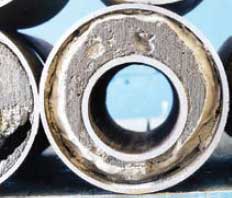The importance of tubular alignment
Of all the components involved in running tubulars, the “Cinderella” of the operation is the casing centralizer. Unexciting, unnoticed and occasionally unattached, the centralizer usually goes unremarked until it fails or a centralization problem occurs.
Cliff Berry, Centek Ltd.
Of all the components involved in running tubulars, the “Cinderella” of the operation is the casing centralizer. Unexciting, unnoticed and occasionally unattached, the centralizer usually goes unremarked until it fails or a centralization problem occurs. Its purpose is to center the casing in the wellbore, allowing cement to circulate freely around the tubular and produce a robust cement seal, ensuring zonal isolation. Not rocket science, but if the centralizer isn’t strong enough to center the pipe, or if it breaks, the consequences can be very expensive. If it breaks in a deviated well, centralization is usually completely lost, rendering effective cementation impossible, and the centralizer may jam the pipe downhole. Stuck drill strings are one of the major contributors to drilling downtime, and a common cause of sticking downhole is a failed centralizer. Annually, some 400 wells worldwide are affected by centralizer problems, at an average cost per well of about $1.5 million producing a total annual loss of $600 million, a loss that is largely preventable. Mud displacement is essential to achieving a good cement bond. The more central the pipe, the more efficient mud displacement will be. In deviated and horizontal wells, if the tubular is not centralized, it will lie along the low side of the borehole, making it very difficult to achieve a uniform cement sheath. Poor centralization can also impair the cement bond by causing channeling, Fig. 1. In addition, if the annular clearance is restricted in some sections, backpressure can result, making it necessary to pump at a very slow flowrate during cementation to avoid fracturing the formation.
Under-reamed wells are among the toughest challenges a centralizer has to face. A major problem with under-reamed wells is getting effective casing centralization in the under-reamed section. Conventional bow-spring centralizers that are wide enough to fit the under-reamed section accurately often get damaged while passing though narrower casings. The bows get a permanent set by being compressed so much that they lose their elasticity and can’t expand to the correct diameter of the under-reamed hole. One response to this problem was the introduction of the solid centralizer. However, this centralizer has a problem when it emerges into the under-reamed section, because with its fixed diameter it is undersized for the under-reamed hole. This is exacerbated in highly deviated under-reamed wells. As in the open hole, the centralizer is too small for effective centralization and will lie on the low side, producing much less effective cementation than a precisely fitting bow spring designed for that wellbore. The latest generation of centralizers is manufactured from a single piece of heat-treated steel, providing a hardened and tempered surface that greatly reduces torque and drag losses. Abrasive wear caused by running to depth and rotating the tubular is virtually eliminated. These centralizers offer high fatigue strength for axial forces and radial side loads on bows during tubular rotation. Reducing torque ensures that casings can be rotated without wear, in both cased and open holes, at a deeper level than before. Despite being fully compressed during casing passage, these centralizers offer restoring force with a very high stand-off ratio, once in the open hole. As low profile units, they take up less annular space, so the ECD signature is low, allowing the operator to pump at a slightly higher rate and improving well cleanout. When running casing, losses can result from not getting to bottom due to friction or mechanical interference, getting packed off or stuck, while extra trips and sidetracks add to well costs. In addition, poor cementation from inadequate stand-off causes improper cement placement, resulting in production delays and early water entry. All these problems can be resolved by ensuring correct centralization. Typical examples of centralizer failure include a land rig in Germany last September. There, centralizers collapsed due to axial load in a horizontal well. The well had 7-in. liner with a length of 1,900 m in a 5,400–m horizontal section. The collapse resulted in 30 days of downtime at a cost of more than $14 million. The solution was fitting centralizers with flexibility, improved stand–off and high axial loading capability to ensure that couplings were kept off the wellbore wall. Another example is from the UK North Sea, Southern Sector, from October 2007. Here a 7-in. liner with a length of 1,100 ft was at an 80° inclination. The liner was stuck with the centralizer packed off and the web broken. The liner was pulled, which resulted in a fishing trip and seven days of downtime at a cost of $6 million. In this case the solution was to improve the flow by area, stand–off and flexibility. Simulations and dynamics were run to fit appropriate centralizers. These examples demonstrate a failure to identify and assess hazards, and then lessen the risk by running the correct centralizers. Before choosing a centralizer, careful consideration, including the use of modeling software, must be given to the flow–by area, desired stand-off, well strength and geometry, the zonal isolation required and the degree of centralizer flexibility needed to traverse known formations, as well as an evaluation of start and running forces.
|
||||||||||
- Coiled tubing drilling’s role in the energy transition (March 2024)
- Using data to create new completion efficiencies (February 2024)
- Digital tool kit enhances real-time decision-making to improve drilling efficiency and performance (February 2024)
- E&P outside the U.S. maintains a disciplined pace (February 2024)
- U.S. operators reduce activity as crude prices plunge (February 2024)
- Drilling advances (January 2024)



